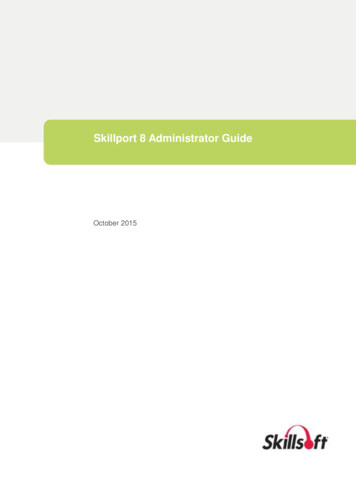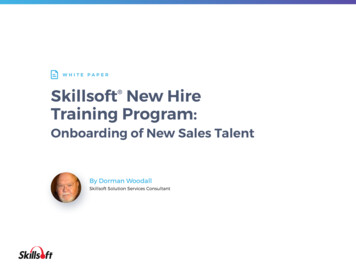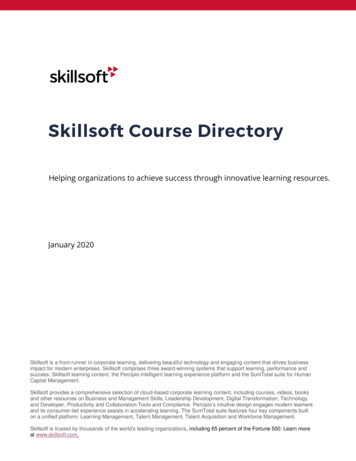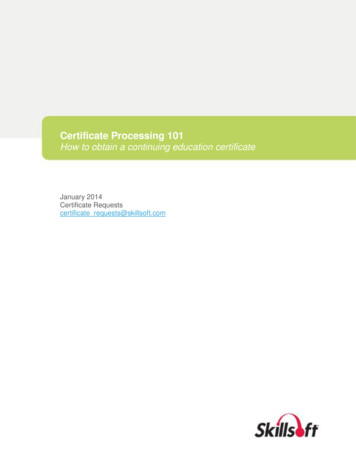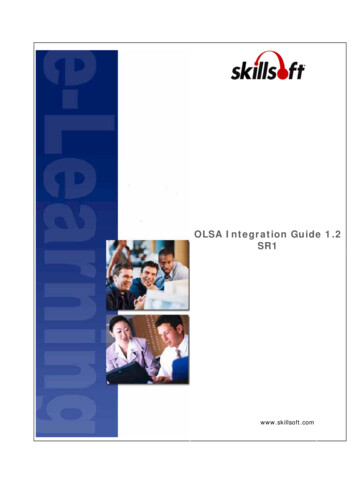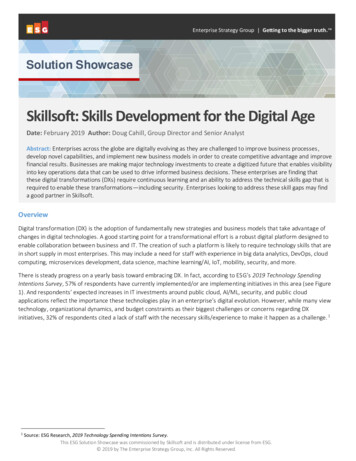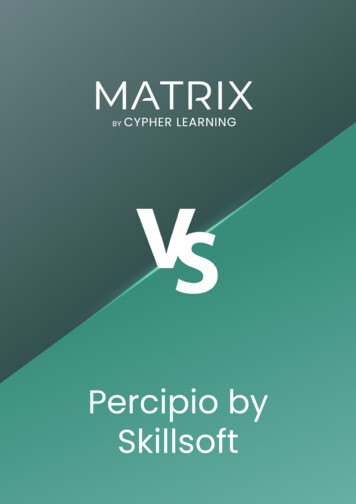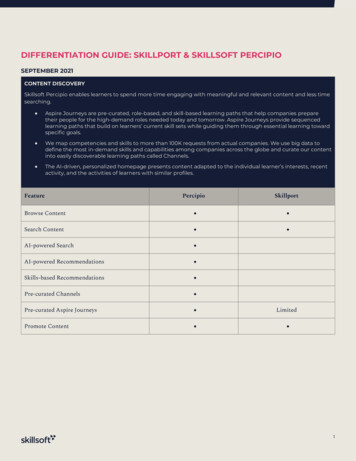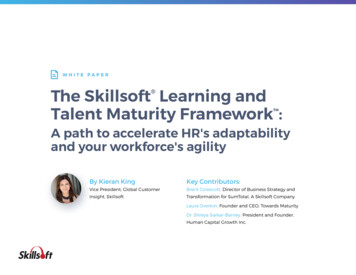
Transcription
WHITE PAPERThe Skillsoft Learning andTalent Maturity Framework : A path to accelerate HR's adaptabilityand your workforce's agilityBy Kieran KingKey Contributors:Vice President, Global CustomerBrent Colescott, Director of Business Strategy andInsight, SkillsoftTransformation for SumTotal, A Skillsoft CompanyLaura Overton, Founder and CEO, Towards MaturityDr. Shreya Sarkar-Barney, President and Founder,Human Capital Growth Inc.
White Paper The Skillsoft Learning and Talent Maturity Framework: A path to HR adaptability and advantageous workforce agilitySHARE ONTA B L E O F CO N T E N T SWarnings have been issued, yet only a few are ready 4What really good looks like the self-developing organization 6The indicators of maturity 7The nine success indicators 8Thought-leader insight: Laura Overton, Managing Director, Towards Maturity 12Why learning maturity matters 12High aspirations of today’s people professionals 12What is holding organizations back? 13Who is achieving the best results? 13What are the top-performing learning organizations doing differently? 14Maturity Matters 15Learning and Talent Management Maturity Framework Matrix 16Thought-leader insight: Shreya Sarkar-Barney, Ph.D., President and Founder,Human Capital Growth A roadmap to business impact 23232
White Paper The Skillsoft Learning and Talent Maturity Framework: A path to HR adaptability and advantageous workforce agilitySHARE ONTA B L E O F CO N T E N T S ( CO N T I N U E D)Why change? 23Significance of the model 23How to change? 24Conclusion: take a step forward 25About the author: Kieran King 26About the key contributor: Brent Colescott 26About the key contributor: Laura Overton 27About the key contributor: Dr. Shreya Sarkar-Barney 273
White Paper The Skillsoft Learning and Talent Maturity Framework: A path to HR adaptability and advantageous workforce agilityWARNINGS HAVE BEEN ISSUED, YET ONLY A FEW ARE READYIn 1997, a groundbreaking McKinsey study exposed workforce vulnerabilities for human resource teams in their book, "The Warfor Talent," yet almost 20 years later as the human capital field is desperate for a revolution, most organizations are not preparedfor battle.SHARE ON“ According to Darwin’s 'Originof Species,' it is not the mostintellectual of the species thatsurvives; it is not the strongestThe dynamics of talent’s low supply and high demand are playing out across the globe, affecting every industry sector and continent.A recent study from PwC called "Redefining Business Success in a Changing World" found that 72% of CEOs are concerned aboutthe availability of key skills and 48% are planning to increase headcount1. However, the majority of human resource teams are stillthat survives; but the species thatsurvives is the one that is ableemploying decades-old traditional practices which don’t come close to addressing the priorities. In fact, a recent Deloitte Universitybest to adapt and adjust to thestudy reports that the percentage of companies rating learning and development as a “very high” priority tripled in a year, yetchanging environment in which itorganizational readiness is declining at a rapid rate. Only 40% of organizations indicated they were ready to face these challenges,which was 35 points less than the year before. This inverse dynamic is more than intellectually disturbing.finds itself.“2Leon C. MegginsonAmid the readiness concerns for the overall workforce, retention and succession gaps are leading to anemic levels of qualifiedleaders. The same PwC CEO study reported that the top talent concern among executives is fortifying the future leadership pipeline3.Leadership capability is seen by CEOs as a key ingredient in an enterprise’s ability to remain competitive and relevant. Given that highperforming leaders relate to a more engaged workforce, better productivity and nearly 50% higher profitability, leadership remains atop challenge for organizations4.In sum, the soft approach many HR teams have taken in the past won’t cut it as organizations strive to meet hardbusiness vulnerabilities.No doubt, it’s difficult to change. The war for talent will involve far more than novel recruiting tactics. It will take wholesale HRadaptation. To some enterprises, this might be quite disruptive. However, the need for organizations to morph how they manageand grow talent is about as fundamental as Darwin’s principles for evolutionary theory itself. Conditions have changed remarkably.The demographic shifts, revamped business models, digitization of products, rise in big data analytics and new forms of competitionrequire organizations to fuel perpetual skill upgrades. HR must evolve to apply new paradigms toward talent attraction, mine forunrealized capability, build rapid development tactics, implement highly effective engagement strategies and unveil succession1 19th Annual Global CEO Survey by PWC. 2016.2 Global Human Capital Trends 2015, Leading in the New World of Work by Deloitte University Press. 2015.3 19th Annual Global CEO Survey by PWC. 2016.4 State of the American Manager by Gallup. April 2015.4
White Paper The Skillsoft Learning and Talent Maturity Framework: A path to HR adaptability and advantageous workforce agilitySHARE ONpathways with far more innovation than they have demonstrated to date. Old assumptions and stale practicesneed to be abandoned. Organizations who successfully compete for talent will exploit technology to achieve asmarter way, build a healthier culture and develop a more resilient petencyManagementOrganizationalGoal Setting,Tracking &CascadingA key part of accomplishing better outcomes involves breaking down the artificial walls between talentCompensationmanagement and learning. Talent management teams possess a wealth of insights into how the workforce needsto be shaped, while inordinate numbers of L&D departments are operating independent of this vital information.As Figure 1 depicts, many organizations unintentionally silo the talent management processes away fromlearning. This “bolted-on” approach results in a clunky experience for employees and causes HR to apply d fixing integration issues instead of building capabilities for the organization.When talent and learning are interwoven, the ability for employees and the organization to achieve its strategicresults can be systemically actualized instead of coincidental. It is vital that HR analyze the business aims and alignCareerManagementtalent and learning to directly support each other. According to the Towards Maturity benchmarking research, theSuccessionPlanningbest-in-class organizations routinely align their efforts with the business strategy. In less mature organizations,only 36% of organizations repeatably look to align to the business agenda5. How can executives be expected totolerate such lack of alignment?IndividualDevelopmentPlansTalent Sourcing& RecruitingOrganizations are recognizing that they must shift from “training” employees with an event-centric approachto designing environments where employee development flourishes as a growth enabler. Developing talent isfar more than setting up a catalog within an LMS and ensuring annual performance reviews take effect. As theFigure 1: Illustrative schematic of talent and learning process dysfunctioninterplay between the talent management and learning pieces gradually becomes more cohesive, and as thealignment to the strategic agenda improves, workforce performance levels increase. Learning becomes a leverthat is truly embraced and encouraged as a synergistic part of the workflow and an intrinsic component of eachtalent facet.Achieving this type of symbiotic relationship between talent and learning not only dissolves silos, it also createscompetitive differentiation. Organizations that apply this modern approach build superior employer brands,entice a higher level of talent to join their ranks and optimize the existing workforce in new ways.5 In-Focus Report: Aligning Learning to Business by Towards Maturity. 2015.5
White Paper The Skillsoft Learning and Talent Maturity Framework: A path to HR adaptability and advantageous workforce agilitySHARE ONW H AT R E A L L Y G OO D L OO K S L I K E T H E S E L F-D E V E L O P I N GO R G A N I Z AT I O NSince Skillsoft has such a vast opportunity to spot best practices we are often asked, “What does good look like?” What the inquirerreally wants to know is what really good looks like. Really good is the self-developing organization.The self-developing organization empowers individuals to take control of their own development and career trajectories.The self-developing organization provides employees with meaningful context regarding their current capabilities as well as a roadmap of what they need to accomplish, putting each employee in the driver's seat. It is unified so that employees don’t need tosearch a multitude of disparate systems to pull together what they need. Self-developing organizations make information actionableso employees not only see what they need to do and what they have done. These organizations seamlessly connect staff to thetools that will arm them for the future. Leaders of self-developing organizations gain insights to keep teams engaged, productiveand collaborative – all key goals in an increasingly competitive global environment. For the organization itself, the self-developingphilosophy enables companies to better attract, retain and reward talent.The self-developing organization is only possible by leveraging the horsepower of a smarter technology solution, with hyperpersonalized development experiences for leaders and individual contributors. It also possesses big data predictive capabilitiesthat come to know each employee’s preferences and future needs. Armed with that intelligence, the system delivers uniquerecommendations before they are sought out and it signifies ways to repurpose employees to enhance talent mobility.The credo of a self-developing organization embodies the following: Learning and talent management efforts and technologies should be coupled together. High-quality, curated content delivered in the context of job performance is essential. Fluid talent mobility is key to keeping employees engaged and it is a competitive lever. Ubiquitous access to learning – delivery at the time and place of need – is critical to knowledge acceleration.6
White Paper The Skillsoft Learning and Talent Maturity Framework: A path to HR adaptability and advantageous workforce agility The user experience must be frictionless and compelling, bringing inherent value to the way work gets done. Technology provides the ability to manage talent and deliver learning in innovative ways. The power of analytics provides insights that can predict demand and serve-up hyper-personalized experiences.SHARE ONClick here to launch thecomplimentary diagnostic.T H E I N D I CATO R S O F M AT U R I T YSkillsoft has the privilege of studying over 6,700 organizations and 45 million employees in 160 countries across a diverse industryspectrum. By collaborating with HR teams around the world, Skillsoft has witnessed a series of highly predictable milestones thatorganizations go through as they shift from perpetuating old ways to adopt pace-setting practices. For more than 10 years, Skillsoftused its Learning Growth Model to help organizations evaluate their learning strategies against a series of maturity stages. That workprovided a firm foundation for us to evolve the model, expanding it to encompass the talent dimension in 2016.This new talent and learning framework is structured into five stages, just as the prior model was. However, the maturity indicatorshave gone through quite a transformation. The new framework has nine indicators because its canvas extends to a larger scope. Eachindicator is described at a high level within this section, and the detailed characterization by stage can be found in the Learning andTalent Maturity Matrix. As your organization examines the indicators and diagnoses its current stage, it is important to keep in mindthat most will not see indicators neatly line up all to one stage. It is far more common to see the majority of indicators under onestage while a few lie in a different stage.By utilizing this framework an organization can identify its current stage for each indicator and understand what milestonesdemonstrate progress to the next stage. Skillsoft also invites organizations to participate in the complimentary online diagnostic, asurvey-based tool that diagnoses the present stage by indicator and provides a playbook-style set of recommendations to ascend tothe next stage.7
White Paper The Skillsoft Learning and Talent Maturity Framework: A path to HR adaptability and advantageous workforce agilityT H E N I N E S U CC E S S I N D I CATO R S1 . O R G A N I Z AT I O N A L C U L T U R E : The people edgeWork culture plays an important role in encouraging employees to put forth their best efforts and it has a significant effect onSHARE ON“ If the CLO can understand whatthose key performance indicatorsare and then cascade them outemployee tenure. This culture determines the way employees interact with one another and how well the organization functionsas key performance indicators forcollectively. Enterprises that intentionally foster a healthy culture often do so because it correlates to increased employeethe learning team, then we inheritengagement, satisfaction and productivity. Today, employees often seek out employers due to their culture. With social mediaservices such as Glassdoor, prospective employees can easily review comments from a company's current and past workers regardingthe very same principles, the verythe leadership, work environment and salary. Annually, Glassdoor ranks companies to devise its Employees’ Choice Awards. Clearly,same objectives, of those we’reinformation about culture has never been more available and this trend is likely to continue to evolve. Organizations with acclaimedtrying to serve. We shouldn’t havecultures have highly supportive leaders focused on people prosperity instead of viewing staff as a scaffold of workers simply hired toperform static jobs.separate and independent keyperformance indicators for justAccording to Towards Maturity benchmarking research, 70% of learning and development teams are not proactive in understandinghow the individuals in their organizations learn6. While it is not for lack of desire, many struggle to fully connect with the employeebase, feeling as though they are pushing boulders up an incline to encourage participation in HR programs. At the root, many HRteams fundamentally do not understand the employees they strive to support. In fact, a recent study found that only one-thirdthe learning function. It should beextremely business relevant.“2 . H R ’ S R O L E A N D S T R AT E G Y : The importance of understandingKieran King, Vice President,Global Customer Insight, Skillsoft7of learning teams have a solid understanding of their audiences’ business priorities, skills, work environments, career interests,digital capabilities or preferences7. The most mature organizations address each member of their workforce as a unique individual.Progressive HR teams also focus on flexible alignment of their team members to remain in close proximity to the business strategy.HR teams operating at the higher levels ensure that the talent and learning structure, roles and supportive processes are tightlyintegrated. They also have a strong understanding of the business objectives and their employees. Under these conditions, HR teamsknow precisely what problems they are trying to solve and as a result, their well-articulated strategy tends to be far more nimble andultimately more successful.6 "Embracing Change: Improving Performance for Business, Individuals and the L&D Team" by Towards Maturity. November 2015.7 "Key Findings: Becoming a High-Impact Learning Organization" by Bersin by Deloitte. 2012.7 "Is Your Organization Ready For the Fast Lane?" by Chief Learning Officer magazine. -agile/8
3 . L E A R N I N G A N D TA L E N T O W N E R S H I P : Who’s in charge of people development?The industry is starting to experience a shift beyond internal programs aimed at training people to innovative environments thatfuel employees to develop themselves. Traditionalists at the lower end of the maturity spectrum tend to view their workforces aspassive sets of audiences. For the more autocratic organizations, the burden for development lies squarely on HR to operationalizeprograms and tell employees when and where they should develop their skills and explore career options. Career mobility is limitedand jobs do not morph frequently. On the other side of the maturity spectrum, the more modern firms catalyze employees to takeactive roles as part of a thriving development environment. These companies foster the responsibility for shaping capabilities andSHARE ON“ In the coming years, self-developingorganizations are going to out-“White Paper The Skillsoft Learning and Talent Maturity Framework: A path to HR adaptability and advantageous workforce agilityperform and out-deliver their peers.Josh Bersin, Principal andFounder, Bersin by Deloitte 8career opportunities by equipping their employees to steer themselves. Managers operate more as coaches, encouraging employeesto take on greater levels of accountability. They also tend to not see employees or their current roles as fixed. Positions can adapt asdynamics change.4 . E N D - U S E R E X P E R I E N C E : Going beyond the three-click ruleToday’s end-users expect more. Contemporary principles and state-of-the-art designs deliver simple, effective and enjoyableexperiences. A great user experience (UX) enables a user to perform a task successfully, while also providing a compelling experience.Less mature organizations underappreciate the importance of the UX, so they concentrate on satisfying a checklist of featuresoriented around HR’s needs (not the employees'). Less mature companies also frequently keep HR’s talent and learning systemsdistinct from one another, making the use of them cumbersome for employees. Employees in these organizations will often complainthat the systems are dated and slow. While hard to believe, in today’s technology-rich landscape some HR teams still rely on paperand pencil processes for development plans and performance appraisals. In the ideal state, function and effortless experienceseamlessly merge, creating a sticky effect that compels employees to explore more of a system's capabilities. This is something moremature organizations appreciate. This class of companies has a tremendous focus on the end-user experience, and they are vigilantabout reducing any friction within the UX. They watch the top consumer end-user experiences closely as their bar to strive toward,since they know employees will bring that level of expectation to the systems they use at work. More mature organizations alsoensure that their workforce doesn’t see distinct lines between using talent and learning systems.5 . T E C H N O L O G Y I N F R A S T R U C T U R E : What’s under the hood will determine the speedCaptivating content and delivery platform combinations provide new possibilities for reaching employees and impacting the business.When an organization melds rich employee profiles with intelligent talent and learning software, the full power of what is possible8 "The 'Self-Developing Organization'" by Josh Bersin, joshbersin.com, March 2, 2015. f-developing-organization/9
White Paper The Skillsoft Learning and Talent Maturity Framework: A path to HR adaptability and advantageous workforce agilitySHARE ONfor the self-developing vision can be realized. Companies at the lower end of the maturity spectrum often lack comprehensive staffprofiles or job descriptions that can inform talent and learning software. They frequently scramble to devise contemporary jobprofiles and they typically have elementary levels of employee data and legacy human resource information systems (HRIS). Moremature organizations maintain an enterprise competency dictionary and robust job descriptions as well as extensive employeeprofiles. These higher-stage organizations view their platforms as a way to maximize the return on human capital so they exploit theadvantage big data algorithms provide, building out “smart systems” that get more intuitive over time.6 . E L E C T I V E P A R T I C I P AT I O N R AT E : If we build it, will they come? It depends on what you’ve builtThe level of endorsement for an organization's talent and learning strategy can be judged by the degree of elective participation itreceives from the “connected population.” The connected population includes employees that have routine access to a personalcomputer or device with access to HR’s learning and talent offerings. Beyond compulsory performance reviews and compliancetraining, how much discretionary use of HR's talent and learning offerings do employees consume? The more mature organizationshave end-user advocates who turn toward the HR experience to continue to grow capabilities and cultivate their careers. There ismore employee “pull.” More mature organizations also leverage engagement tactics fueled by big data to encourage more voluntaryparticipation. Less mature organizations have very low elective participation rates and rely on very self-motivated individuals to gobeyond the obligatory asks. The less mature organizations also tend to employ traditional marketing techniques to spur electiveparticipation so the uptake is directly influenced by the effectiveness of their “push” campaigns.7 . G O V E R N A N C E : Moving from nomadic efforts to natural controlsHR’s ability to instill governance is a clear sign of its maturity level. For the less mature organizations, the structure for talent andlearning is highly decentralized. It lacks guardrails where efforts are not monitored so there is little coordination between HR’sown efforts and its interface with other enterprise functional groups. As organizations evolve toward higher maturity phases, theygradually see that they must implement more controls in order to get a stronger handle on decision-making, forward-looking plans,resources and cost. At the middle stage of maturity it is common for organizations to establish steering committees that eventuallytransition into formal governance. In fully mature organizations, the governance for both learning and talent jurisdiction is intuitive.These organizations also operate from a fact base of data to optimize efficiency and continually enhance their effectiveness.8 . F U N D I N G : Do you need a GPS to determine where the money is going?While a distributed or federated model of funding may seem liberated, in the end, organizations typically find that they must reinin expenses to maximize their effect. Less modern organizations focus on constant reduction of expenses; there is no predefined10
White Paper The Skillsoft Learning and Talent Maturity Framework: A path to HR adaptability and advantageous workforce agilitySHARE ONtalent investment and spend levels tend to be underwater compared to industry benchmarks. Cloud-based learning is frequentlyimplemented in order to increase scale and offset more expensive training delivery options. Funding processes are not uniformand HR is often subject to disproportionate reductions when economic times are tight. As an organization’s strategy matures,rationalization efforts emerge which are often taken up along with procurement counterparts. In more evolved companies, talent isIf organizations choose to standstill, immobilized from evolvingviewed as key investment that directly influences the organization’s strategic success. Therefore at the higher levels, budget in humandue to the enormity of it all, theycapital often exceeds industry benchmarks. Funding strategies are also artfully coordinated through advanced governance.will invariably fall behind. It’s9 . M E A S U R E M E N T : Without data, it’s just an opinionIn literally every function, data-driven decisions are becoming more prevalent and HR is no exception. In the early stages ofmaturity, organizations tend to focus on garnering participation measures to provide a proxy for success. They use participationrates as the principle means of articulating value. Reporting efforts are often ad-hoc and reactionary. As enterprises move up thenot a matter of if such paralysiswould compromise organizationaloutcomes, but rather, byhow much.maturity framework, their efforts become more proactive and the combinations of data inputs stem outside of what falls within theboundaries of the HR function. As an organization moves beyond traditional practices and transforms, business impact becomes akey measurement pursuit. Productivity metrics become more regular and the organization defines a philosophy regarding learningand talent measurement. As an organization progresses up the maturity model, it steadily increases its own self-discipline towardevidence-based decisions. Eventually, a dedicated practice for measurement is created, including sophisticated data visualizations,statistically oriented software and predictive data modeling.11
White Paper The Skillsoft Learning and Talent Maturity Framework: A path to HR adaptability and advantageous workforce agilitySHARE ONThought-leader insightLaura Overton, Managing Director, Towards MaturityW H Y L E A R N I N G M AT U R I T Y M AT T E R SIf there is one element that we’ve seen add real value back to the business, its learning maturity! Towards Maturity’s research withover 4,500 L&D and HR leads around the globe shows that mature learning and development (L&D) teams are not only achieving theirfull potential but they are unleashing the capability of the businesses and individuals they serve. They have moved beyond the roleof pure course provider and deliverer of “more for less.” They embrace the application of innovative learning strategies to activelysupport business success. What’s more, business leaders around the globe are sitting up and valuing that contribution.H I G H AS P I R AT I O N S O F TO DAY’S P E O P L E P R O F E S S I O N A L SMaturity matters to all of us regardless of sector, regardless of location. In our last study with 600 L&D leaders, we found that themajority of L&D leaders are hungry to add value back to the business. They recognize that this demands a shift in focus from purelydelivering programs to adding real organizational value and placing an active role in creating a culture of learning. Inspired by a widerange of technologies to support learning and talent we found that at least nine out of 10 are looking to: Increase efficiency of learning delivery (e.g. 98% are looking to improve flexibility/access to learning and 88% want to provecompliance more effectively) Improve individual process (e.g. 95% are looking to improve the onboarding process) Add to overall productivity and employee engagement (e.g. 94% are looking to adapt programs to individual need/context) Improve overall business responsiveness and agility (e.g. 94% looking to provide a faster response to changingbusiness conditions) Play a leading role in building an active learning culture (e.g. 96% are looking to improve the sharing of good practice)12
White Paper The Skillsoft Learning and Talent Maturity Framework: A path to HR adaptability and advantageous workforce agilitySHARE ONHowever, whilst 75% of L&D leaders are making progress in improving compliance, fewer than half of them areThere are a number of barriers holding us back including: Lack of skill to embrace technology: L&D leaders are applying more technologies to their learning solutionsyet 56% of them do not feel their teams have the skills to embrace new technologiesPerception of learner reluctance: 63% of L&D leaders believe their staff members lack the skill to managetheir own learning Lack of management backing: 48% claim that learning is not seen as a management priority Technology barriers: 33% report lack of support from ITORGANIZATIONW H AT I S H O L D I N G O R G A N I Z AT I O N S B AC K?PROGRAMachieve. The proportion of organizations that are achieving their goals is depicted in Figure 2.CULTUREachieving their aspirations. In fact, we have seen that each of these stages of maturity are increasingly difficult toLEARNINGCULTUREAchieved by 21%BUSINESSRESPONSIVENESSAchieved by 24%PRODUCTIVITY ANDENGAGEMENTAchieved by 29%INDIVIDUALPROCESSAchieved by 39%EFFICIENCYAchieved by 41%Figure 2: To what extent are goals being achieved? n 600. Used and adapted with permission.WHO IS ACHIEVING THE BEST RESULTS?Over the years, Towards Maturity has found that organizations that are executing their efforts within a frameworkof six workstreams are more successful. These workstreams within the Towards Maturity Framework are listedbelow. Organizations measure their maturity against the framework using the Towards Maturity Index :1.Defining need2.Understanding learner context3.Understanding work context4.Building capability5.Ensuring engagement6.Demonstrating valueFigure 3: the Towards Maturity Framework - Six workstreams of success13
White Paper The Skillsoft Learning and Talent Maturity Framework: A path to HR adaptability and advantageous workforce agilitySHARE ONSo at a high level, success is not linked to a specific mode of technology, budget size or headcount. Rather, it’s about applyingbusiness sense to learning strategy.Importantly, Top Deck organizations, those who reside at the upper 10% of the Towards Maturity Index , consistently reportbetter results: 3 times more likely to report ben
The Skillsoft Learning and Talent Maturity Framework : A path to accelerate HR's adaptability and your workforce's agility By Kieran King Vice President, Global Customer Insight, Skillsoft Key Contributors: Brent Colescott, Director of Business Strategy and Transformation for SumTotal, A Skillsoft Company


